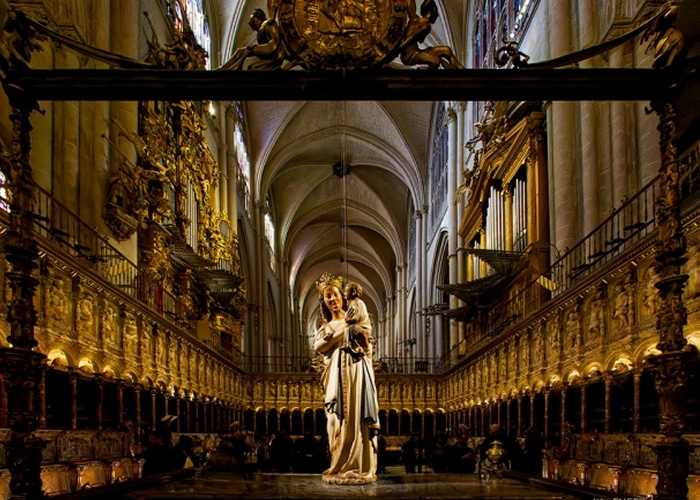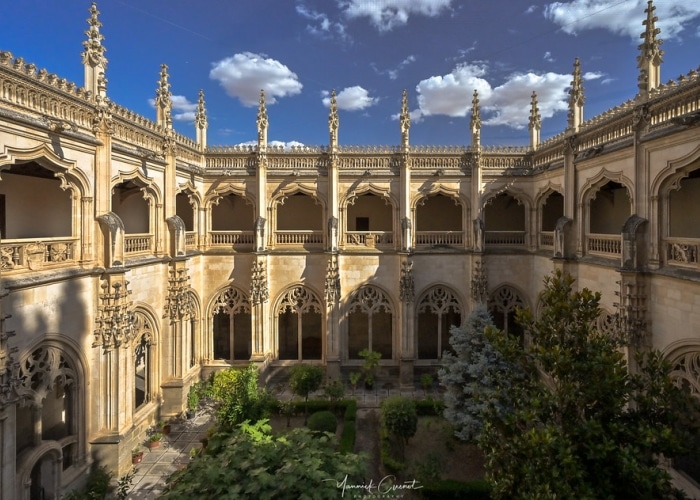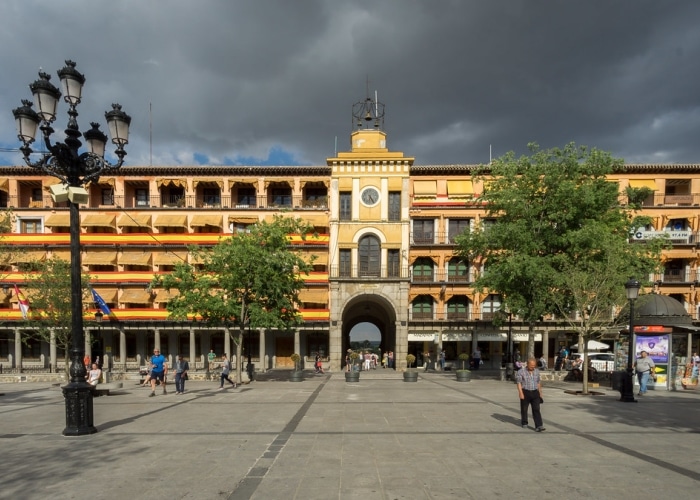Above the Tagus, Toledo rises tightly on its spur, with warm stone and cool shade. To travel through Toledo is to wander crossing lanes, steel workshops, Mudejar bricks, churches echoing synagogues. You walk slowly, the slope setting the pace.
In the Cathedral of Saint Mary, light falls in sheets, chapels brimming with detail. Nearby, the Alcázar crowns the ridge, austere, with wide views over the rooftops. Crossing the Puente de San Martín slows your steps, the water below filling the silence.
You stop for a coffee, a piece of mazapán, a patio stumbled upon by chance. Toledo at dusk is best seen from the Mirador del Valle, turn after turn, the city lit like a model. You leave unhurried, already thinking of returning.
For a touch of nature, head to the Barrancas de Burujón, spectacular red cliffs just outside the city.
Top 5 Guided Tours
Places to Visit

In front of Toledo’s Cathedral of Saint Mary, you slow down. The gray stone, sculpted portals, and sunlit towers all invite you to push open the great door. Inside, the air cools and the atmosphere softens.
Your eyes move to the finely carved choir, then to the rich altarpiece. You linger beneath the Transparente, where light pours down in cascades. In the sacristy, an El Greco captures attention, quiet yet compelling.
To visit Toledo without rushing, the cathedral deserves time. It’s best to come early, or late in the afternoon, when the hum replaces hurried groups. You leave with fragments in mind, details you won’t forget.
Nearby, a few places extend the walk: the Plaza de Zocodover for a pause, the Alcázar of Toledo for its views, the Monastery of San Juan de los Reyes for its calm. The Cathedral of Saint Mary remains the thread running through it all, simple and clear.

In the narrow lanes of Toledo’s old Jewish quarter, you walk past plain facades, sometimes marked with a star carved into the stone. The atmosphere feels distinct—silence mixed with traces of a past still present in the walls. It’s easy to picture the comings and goings of the families who once lived here.
The Synagogue of Santa María la Blanca surprises with its brightness. Its light, white arches reflect Muslim influence intertwined with the city’s Jewish history. Nearby, the Synagogue del Tránsito houses the Sephardic Museum, filled with objects, texts, and memories.
Toledo’s Jewish heritage isn’t limited to these landmarks. It lingers in the small courtyards, the faded inscriptions, the worn stones brushed as you pass. Each turn of the labyrinth tells a story, often in fragments.
After this walk, you might head to the Plaza de Zocodover or follow the Tagus along the ramparts, easing back into the present-day city. The contrast deepens the impression left by the Jewish quarter—quiet and profound.

The Alcázar of Toledo towers over the city, solid on its rocky spur. You spot it from afar, its four square towers cutting into the horizon. As you draw closer, its imposing bulk becomes clear, almost intimidating.
Inside, the building now houses the Army Museum. Entire halls recount Spain’s military history, with weapons, armor, and old maps. There are also quieter exhibitions, giving you a chance to breathe between galleries.
From the terraces, wide views open over Toledo and the Tagus River. Visitors often stay longer than planned, eyes drawn to the packed rooftops of the old town. The contrast between the massive stone and the shifting landscape is striking.
From the Alcázar, it’s easy to reach the Cathedral of Saint Mary or walk down to the Plaza de Zocodover. The monument keeps its proud presence, yet it fits naturally into a visit to Toledo, balancing strength and memory.

The Monastery of San Juan de los Reyes hides behind high walls, away from the bustle. Built in 1476 by the Catholic Monarchs after the Battle of Toro, it still bears the chains of freed Christian prisoners hanging from its facade. The detail is startling—harsh, yet meaningful.
Inside, the cloister draws attention immediately. Its arcades open onto a peaceful garden, where the light shifts throughout the day. The carefully crafted Gothic vaults give a sense of lift and lightness.
Visitors often linger in silence, sitting on a bench, simply watching the play of shadows. Time feels slower here, as though Toledo’s energy has been left outside. The calm is heavy, but pleasantly so.
Stepping back out, you can continue the walk toward the Alcázar or the Cathedral of Saint Mary. The monastery itself remains tied to that feeling of retreat, almost timeless, that colors the memory of Toledo.

The Plaza de Zocodover has always been the beating heart of Toledo. Once a market where goods and conversations mingled, it remains today the place where people meet. The arcaded facades shelter cafés and shops, giving the square a familiar atmosphere.
From a terrace seat, you watch students, families, and travelers go by. The rhythms shift with the time of day: calm in the morning, busier in the afternoon, lively in the evening. Each visit brings a new scene—sometimes noisy, often warm.
The square isn’t large, but it concentrates the city’s energy. Festivals, gatherings, and daily routines all intersect here. It’s easy to see why locals keep coming back, again and again.
From Plaza de Zocodover, it’s a short walk to the Alcázar, the Cathedral of Saint Mary, or the lanes of the old Jewish quarter. The square acts as a crossroads, a simple point of departure and return in any visit to Toledo.